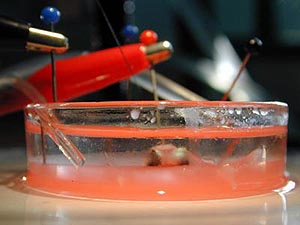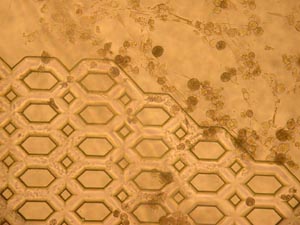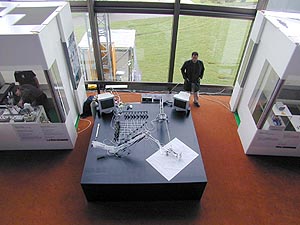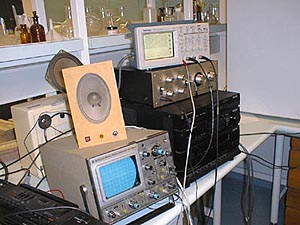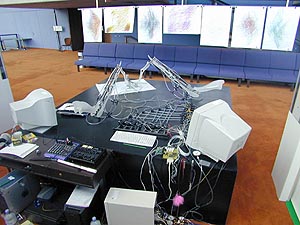| |
|
| http://www.critical-art.net/index.html |
| |
|
| |
http://www.symbiotica.uwa.edu.au/
http://www.symbiotica.uwa.edu.au/research/fishnchips.html |
| |
|
| |
| |
| http://www.gene-sis.net/artists_manglano-ovalle.html |
| http://jdwelch.net/history/manglano.htm |
| http://www.wexarts.org/thefold/inigo/ |
| |
| http://www.macfound.org/programs/fel/2001fellows/manglano_ovalle.htm |
| |
| http://www.geneart.org/ovalle1.htm
Banks
in Pink and Blue, 1999
mixed mediums, liquid nitrogen, and human semen, dimensions variable
(installation view)
Courtesy of Max Protetch gallery
A gender-selected cryogenic sperm bank, Banks in Pink and Blue consists
of a number of distinct components and agreements integral to the
creation of a sculpture intended to preserve the viability of donated
or “lender” sperm samples in cryogenic suspension for
an undetermined period of time. While each sample is understood
to be the property of the lender, the work functions as a corporate
entity and generates appropriate contractual agreements with individual
donors regarding preservation, ownership, and use of samples, including
agreements between donors and the institutions that preserve and
publicly display these samples. The project involves the contributions
of twenty-five to one hundred sperm lenders selected by the artist
as well as the participation of medical ethicists, geneticists,
private biotech companies, lawyers, and legal consultants. Banks
in Pink and Blue brings together disparate concerns of aesthetics,
genetics, law, and ethics, addressing such issues as the possible
transfer of sample ownership from the lender to the corporation
or to other individuals. This installation includes a pair of self-contained
cryobanking systems, the portable repositories known as Dewar flasks
used by genetic laboratories, and commercial sperm banks for the
preservation and long-term storage of specimens in the medium of
liquid nitrogen. One of the outer aluminum shells of these repositories
is colored pink, and the other a light blue. Since the banks must
be periodically replenished with liquid nitrogen, the installation
also contains a large stainless steel tank, which is used to maintain
the frozen semen specimens at -321°. The vessels and the samples
they contain are displayed as sculpture in the gallery setting.
Each lender is provided with a kit containing cryogenic transport
media and instructions for private semen collection. The sample
is then shipped to the artist by overnight air service for centrifugal
separation for gender selection of spermatozoa carrying the Y- or
X-sex determinant chromosome. Each sample is then stored in the
appropriate pink or blue cryobank. The project is investigating
the possibility that the art work may have a predetermined lifespan
of twenty years, which would allow for its exhibition at other venues
at future dates. |
| |
http://www.insite2000.org/artistfinal/Manglano-Ovalle/more.html
Manglano-Ovalle’s
piece consisted of transforming the bullring in Playas de Tijuana,
located next to the border with the US, into a radio telescope in
search of aliens. The piece was monumental and minimalist at the same
time, and communicated the clear metaphor that is embodied in the
title -Search/En Búsqueda. The work functioned at a local level,
being at a specific site, while at the same time it was "a global
event, possibly cosmic" (Iñigo Manglano-Ovalle). The signals
received by the antenna were transmitted via radio, internet, and
through loudspeakers around the ring. However, as the artist wrote
in his proposal: ´In reality contact with "the real aliens"
(at the border or in space) will most likely never happen so the station
[...] will probably never transmit a discernible signal. It will only
broadcast the sound of "listening" (white noise).� |
| |
| |
| |
http://www.geneart.org/burson.htm
The Human Race Machine, 2000
computer software and hardware, black formica case and chair
case: 64 x 24 x 48 in. chair: 64 x 24 x 16 in. (detail)
My intention in building The Race Machine was to allow us to move
beyond difference and arrive at sameness. When I discovered, while
doing research on a project involving genetics, that there is no gene
for race, I felt it was one of the most important things to understand
about genetics. The DNA of any two humans is 99.97 percent identical.
And then The Race Machine became The Human Race Machine. We are all
related, all connected, all one. |
| |
| http://www.nancyburson.com/ |
| http://strikingdistance.com/unreal/Pages/irit01.htm |
Nancy
Burson was one of the first artists to realize the creative potential
of linking computers with photography in the early 1980's. Her patented
aging machine, which simulated the process of aging in the human face,
not only pioneered the current artistic practice of 'morphing' and
computer altered photography, but was also licensed by the FBI. The
aging machine has been successfully used to locate missing children,
even years after their disappearance. The machine was a collaboration
with Burson's spouse, David Kromlich. It combined images of the missing
child's pictures at the time of their disappearance with those of
an older family member. It showed, often quite accurately, how the
child's face might change over time.
She with He, 1996 and He with She, 1996 are part of Burson's twenty
year undertaking of a profound exploration of the human face. They
are morphs of male and female faces, representations of androgyny.
Burson preserves the appearance of layering in the morphing process
as the apparition of one image is seen through the other. These faces
emerge like visitors from another world, or a future time. Androgyny,
these pictures seem to be saying, is a state that we, as a species,
is evolving into. Burson displays the transformation in mid stream
as if we are looking at a hallucination that is being created before
our eyes. |
| |
| http://www.pbs.org/wnet/egg/205/burson/index.html |
| |
| |
| http://www.duke.edu/~giftwrap/ |
| http://www.duke.edu/~lmk2/INTERFACE/grey.html |
| http://www.duke.edu/%7Egiftwrap/Zoobs.html |
| http://www.absolutearts.com/artsnews/2003/03/03/30796.html |
| http://media2.bmrc.berkeley.edu/projects/act/lec2.html |
| |
| |
| Natalie
Jeremijenko |
|
"One
Tree" 1999 |
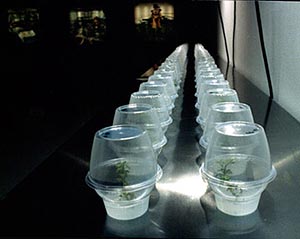 |
|
"Cloning
has made it possible to Xerox copy organic life and fundamentally
confound the traditional understanding of individualism and
authenticity. In the public sphere, genetics is often reduced
to ìfinding the gene for (fill in the blank),î
misrepresenting the complex interactions of the organism with
environmental influences. The swelling cultural debate that
contrasts genetic determinism and environmental influence
has consequences for understanding our own agency in the world,
be it predetermined by genetic inevitability or constructed
by our actions and environment. The OneTree project is a forum
for public involvement in this debate, a shared experience
with actual material consequences.
OneTree
is actually one hundred tree(s), clones of a single tree micropropagated
in culture. These clones were originally exhibited together
as plantlets at Yerba Buena Center for the Arts, San Francisco,
in 1999. This was the only time they were seen together. In
the spring of 2001, the clones will be planted in public sites
throughout the San Francisco Bay Area, including Golden Gate
Park, 220 private properties, San Francisco school district
sites, Bay Area Rapid Transit stations, Yerba Buena Performing
Arts Center, and Union Square. A selection of international
sites are also being negotiated. Friends of the Urban Forest
are coordinating the planting. Because the trees are biologically
identical, they will render the social and environmental differences
to which they are exposed in subsequent years. The treesí
slow and consistent growth will record the unique experiences
and contingencies of each public site. The tree(s) will become
a networked instrument that maps the microclimates of the
Bay Area, connected through their biological materiality.
People can view the tree(s) and compare them, a long, quiet,
and persisting testament to the Bay Areaís diverse
environment." [12] |
|
| |
| http://cat.nyu.edu/natalie/ |
| |
| http://cat.nyu.edu/natalie/OneTree/OneTreeDescription.html |
| |
| http://www.onetree.org/ |
| |
| http://bureauit.org/data/ |
| |
| http://www.thing.net/~tenacity/jerem.html |
| |
|





